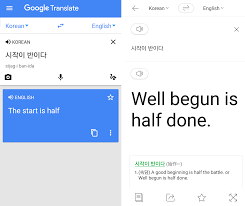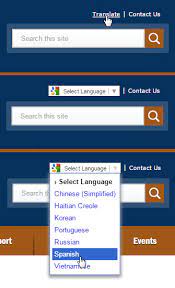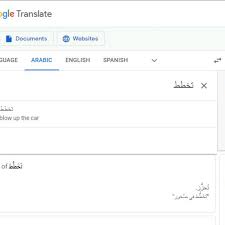Google Translate: Breaking Down Language Barriers
In today’s interconnected world, language barriers can often hinder effective communication and understanding between individuals from different linguistic backgrounds. However, thanks to technological advancements, we now have access to powerful tools like the Google Translate website, which has revolutionized the way we bridge these gaps.
Google Translate is a free online translation service provided by Google that allows users to translate text, documents, websites, and even speech in real-time across multiple languages. With just a few clicks, users can communicate with people from around the world without needing to learn their language or rely on human translators.
One of the most remarkable aspects of Google Translate is its ability to handle a vast number of languages. Currently supporting over 100 languages, including major global languages like English, Spanish, French, Chinese, Arabic, and many more, this powerful tool covers a significant portion of the world’s population.
The website interface itself is simple and user-friendly. Users can enter text directly into the translation box or upload documents for instant translation. Additionally, there is an option for speech input where users can speak into their device’s microphone and have it translated in real-time.
Google Translate utilizes advanced machine learning algorithms and artificial intelligence to continuously improve its accuracy and naturalness. As millions of users interact with the platform daily, it learns from their translations and adjusts its algorithms accordingly. This constant feedback loop helps refine translations over time.
While it is important to note that automated translation systems like Google Translate may not always provide perfect translations due to linguistic complexities and context-specific nuances, it serves as an invaluable tool for basic communication needs. It enables individuals to grasp the general meaning of foreign texts or conversations quickly.
Moreover, Google Translate goes beyond just translating individual words or phrases; it also offers features like website translation. By entering a URL into the translation box or using browser extensions available for Chrome users, entire web pages can be translated into your preferred language, opening up a world of information and content that would otherwise be inaccessible.
Google Translate has also contributed significantly to breaking down language barriers in the business world. It allows companies to communicate with international clients and partners more effectively, facilitating global trade and collaboration. Small businesses can now reach a broader audience by translating their websites or marketing materials into multiple languages without significant costs.
As with any technology, it is crucial to use Google Translate responsibly and be aware of its limitations. It is always recommended to double-check translations for important documents or critical communication. However, for everyday use and casual conversations, Google Translate has proven to be an invaluable tool for connecting people across different languages and cultures.
In conclusion, the Google Translate website is a game-changer in the field of language translation. By providing a free and accessible platform that supports numerous languages, it has become an essential tool for breaking down language barriers worldwide. As technology continues to advance, we can expect even more remarkable developments in the realm of translation, further enhancing global communication and understanding.
Frequently Asked Questions About Using Google Translate for Websites
- Can Google automatically translate a website?
- How do I translate a website to English?
- Do websites automatically translate?
- What is Google Translate URL?
- How do I use Google Translate on a website?
Can Google automatically translate a website?
Yes, Google Translate has a feature that allows for automatic translation of websites. By entering the URL of a website into the translation box on the Google Translate website or using browser extensions available for Chrome users, users can have the entire web page translated into their preferred language.
When a website is translated using Google Translate, the text and content of the original website are automatically analyzed and translated into the selected language. This feature enables users to access and understand content from websites that may be written in languages they are unfamiliar with.
It’s important to note that while Google Translate’s website translation feature can be helpful in providing a general understanding of foreign websites, it may not always produce perfect translations. The accuracy and naturalness of translations can vary depending on factors such as linguistic complexities and context-specific nuances. Therefore, it is advisable to review and verify translations for important or critical information.
Overall, Google Translate’s automatic website translation feature is a valuable tool for accessing information from websites in different languages, allowing users to overcome language barriers and explore content from around the world.
How do I translate a website to English?
Translating a website to English can be done using various methods. Here are a few options you can consider:
- Google Translate: Visit translate.google.com and enter the URL of the website you want to translate into the text box on the left side. Select the source language of the website, and then choose English as the target language. Google Translate will attempt to translate the entire webpage for you.
- Browser Extensions: Many web browsers offer extensions or add-ons that automatically translate webpages into your preferred language. For example, Google Chrome has an extension called “Google Translate” that can be installed from the Chrome Web Store. Once installed, it will provide an automatic translation option whenever you visit a webpage in a foreign language.
- Website Translation Services: Some websites offer their own built-in translation services. Look for language options or translation buttons on the website itself. These services may provide more accurate translations specifically tailored for that website.
- Professional Translation Services: If you require high-quality and accurate translations, especially for business purposes, it is recommended to hire professional translators or translation agencies specializing in website localization. They can ensure culturally appropriate translations while maintaining accuracy and consistency throughout your website.
Remember that automatic translation tools may not always provide perfect translations due to linguistic complexities and context-specific nuances. It is always advisable to review and proofread translated content to ensure accuracy, especially for important documents or critical communication.
Additionally, keep in mind that translating a website is not just about translating text; it may also involve adapting images, graphics, navigation menus, and other elements to suit different languages and cultural preferences.
Choose the method that best suits your needs based on factors such as accuracy requirements, budget considerations, and time constraints.
Do websites automatically translate?
Websites do not automatically translate themselves. However, with the help of translation tools and plugins, website owners can make their websites accessible to users who speak different languages. These tools can automatically translate the content of a website into a user’s preferred language, allowing them to understand and navigate the site more easily.
There are various methods for implementing website translation. Some website owners use machine translation services like Google Translate or Microsoft Translator, which provide automated translations. These services offer plugins or code snippets that can be integrated into a website, enabling visitors to translate the content with a simple click.
Other website owners may choose to hire professional translators to manually translate their website’s content. This approach typically yields more accurate and contextually appropriate translations, especially for businesses or organizations that require precise communication.
Additionally, some content management systems (CMS) have built-in multilingual features that allow website owners to create and manage translated versions of their site. This enables them to maintain consistent branding and user experience across different languages.
It’s important to note that while automated translation tools have improved significantly in recent years, they may not always produce perfect translations due to linguistic complexities and context-specific nuances. Therefore, it is advisable for businesses or organizations that rely heavily on accurate communication to consider professional human translation services for their websites.
In summary, while websites do not automatically translate themselves, there are tools and plugins available that can facilitate automatic translation for users. Website owners have the option to choose between machine translation services or professional human translators depending on their specific needs and priorities.
What is Google Translate URL?
The URL for Google Translate is: https://translate.google.com/
How do I use Google Translate on a website?
Using Google Translate on a website is a simple process. Here’s a step-by-step guide:
- Open your preferred web browser and go to the Google Translate website (translate.google.com).
- On the left side of the page, you will see a text box labeled “Enter text.” This is where you can type or paste the text you want to translate.
- Below the text box, you’ll find two drop-down menus. The first menu allows you to select the language of the original text, while the second menu lets you choose the language you want to translate it into. Click on each menu and select the appropriate languages.
- Once you’ve entered your text and selected the languages, Google Translate will automatically display the translated version on the right side of the page.
- If you want to translate an entire webpage, click on the link labeled “Translate a document” just below the translation box. On this page, you can either enter a URL for a specific webpage or upload a document file for translation.
- To translate a webpage, enter or paste its URL in the provided field and select the desired languages for translation from the drop-down menus.
- After entering all necessary information, click on “Translate” to initiate the translation process.
- Google Translate will then display a new page with your translated webpage or document.
Please note that while Google Translate provides convenient translations, it may not always capture complex nuances accurately due to linguistic challenges and context-specific meanings. It’s recommended to review and verify translations for important content or critical communication purposes.
Additionally, there are browser extensions available for Chrome users that allow automatic translation of webpages without having to visit translate.google.com each time.
By following these steps, you can easily use Google Translate to translate both individual text snippets and entire webpages according to your needs and preferences.




